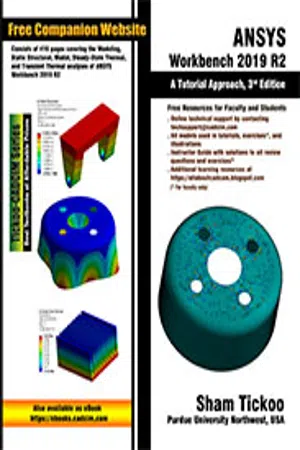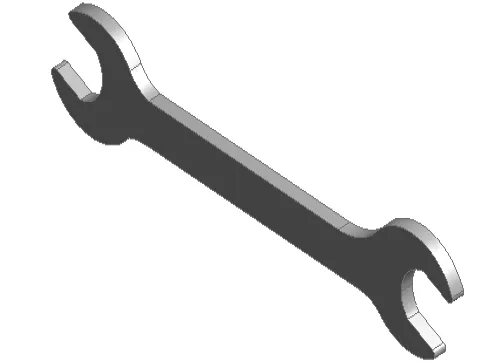
- English
- ePUB (mobile friendly)
- Available on iOS & Android
ANSYS Workbench 2019 R2: A Tutorial Approach, 3rd Edition
About this book
ANSYS Workbench 2019 R2: A Tutorial Approach ebook introduces the readers to ANSYS Workbench 2019, one of the world's leading, widely distributed, and popular commercial CAE packages. It is used across the globe in various industries such as aerospace, automotive, manufacturing, nuclear, electronics, biomedical, and so on. ANSYS provides simulation solutions that enable designers to simulate design performance. This book covers various simulation streams of ANSYS such as Static Structural, Modal, Steady-State, and Transient Thermal analyses. Structured in pedagogical sequence for effective and easy learning, the content in this textbook will help FEA analysts in quickly understanding the capability and usage of tools of ANSYS Workbench.
Salient Features
- Book consisting of 11 chapters that are organized in a pedagogical sequence
- Summarized content on the first page of the topics that are covered in the chapter
- More than 10 real-world mechanical engineering problems used as tutorials
- Additional information throughout the book in the form of notes and tips
- Self-Evaluation Tests and Review Questions at the end of each chapter to help the users assess their knowledge
Table of Contents
Chapter 1: Introduction to FEA
Chapter 2: Introduction to ANSYS Workbench
Chapter 3: Part Modeling - I
Chapter 4: Part Modeling -II
Chapter 5: Part Modeling - III
Chapter 6: Defining Material Properties
Chapter 7: Generating Mesh - I
Chapter 8: Generating Mesh – II
Chapter 9: Static Structural Analysis
Chapter 10: Modal Analysis
Chapter 11: Thermal Analysis
Index
Frequently asked questions
- Essential is ideal for learners and professionals who enjoy exploring a wide range of subjects. Access the Essential Library with 800,000+ trusted titles and best-sellers across business, personal growth, and the humanities. Includes unlimited reading time and Standard Read Aloud voice.
- Complete: Perfect for advanced learners and researchers needing full, unrestricted access. Unlock 1.4M+ books across hundreds of subjects, including academic and specialized titles. The Complete Plan also includes advanced features like Premium Read Aloud and Research Assistant.
Please note we cannot support devices running on iOS 13 and Android 7 or earlier. Learn more about using the app.
Information



Table of contents
- CoverImage
- ANSYS_WB_2019_Front Matter_cs6_ebook
- c01_ansys_wb_2019_R2_CS6_ebook
- c02_ansys_wb_2019_R2_cs6_ebook
- c03_ansys_wb_2019_r2_cs6_ebook
- c04_anays_wb_2019_R2_cs6_ebook
- c05_ansys_wb_2019_R2_cs6_ebook
- c06_ansys_wb_2019_R2_cs6_ebook
- c07_ansys_wb_2019_R2_cs6_ebook
- c08_ansys_wb_2019_r2_cs6_ebook
- c09_ansys_wb_2019_R2_cs6_ebook
- c10_ansys_wb_2019_cs6_ebook
- c11_ansys_wb_2019_cs6_ebook
- lastpage_Ansys_2019_R2_cs6_ebook